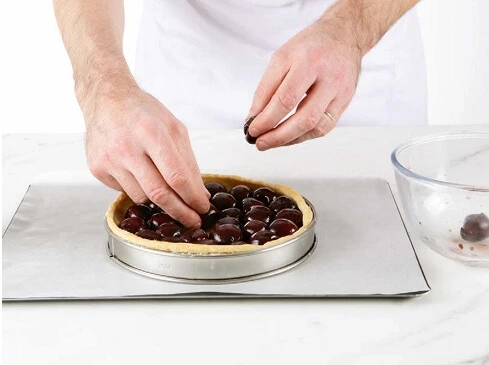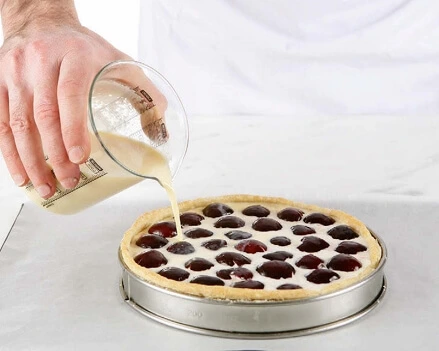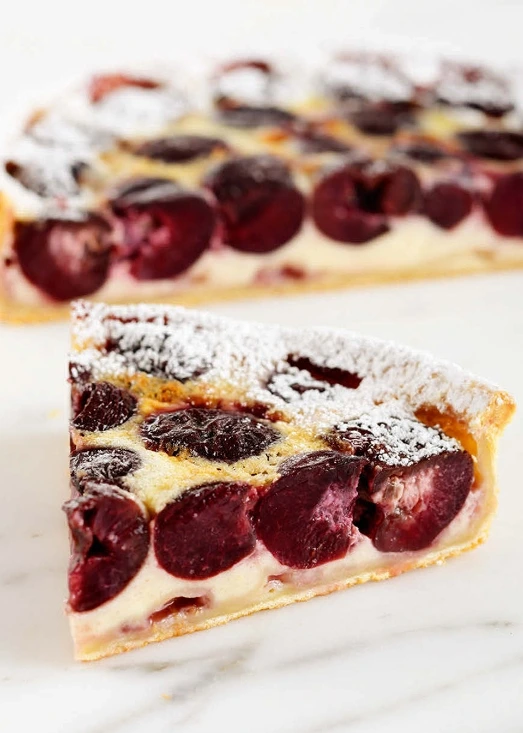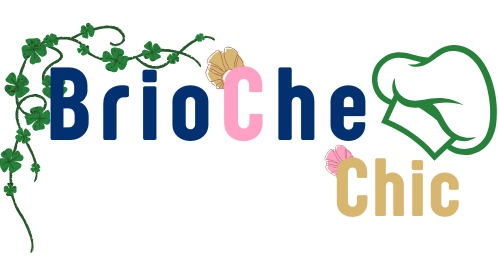cherry clafoutis perfect tart
Some desserts transcend time and trend, offering not just taste but memories. Cherry clafoutis is one such treasure — a beloved staple of French home baking that blends rustic elegance with quiet sophistication. Born in the heart of the Limousin region, this dish transforms ripe cherries into a celebration of the season, nestled in a custard-like batter that’s tender, golden, and delicately perfumed.
Clafoutis is more than just a dessert — it’s a story. It tells of sunlit orchards, lazy summer afternoons, and kitchens filled with the scent of warm fruit and vanilla. Its texture is somewhere between a flan and a soft cake, and every bite offers the sweet-tart burst of cherries wrapped in silky softness. Served warm, at room temperature, or chilled, it adapts to every mood and every moment.
Though its preparation may appear simple, true success lies in the details: the perfect ripeness of the fruit, the smoothness of the batter, the precision of the bake. Some add a hint of almond or a dash of kirsch, others keep it purely traditional — but all agree on its quiet power to please. Finished with a dusting of powdered sugar, clafoutis never clamors for attention. Instead, it gently captures the heart.
In the world of Brioche Chic, where tradition meets refinement, cherry clafoutis is right at home — a dessert that doesn’t need adornment to be unforgettable. It’s the kind of recipe that brings generations together, served simply and savored slowly, with a nod to heritage and a taste of home.
Cherry Clafoutis – Full Recipe for 6 Servings
Preparation Time
– Prep: 30 minutes
– Chilling: 1 hour
– Baking: 1 hour
– Storage: Up to 3 days in the refrigerator
Required Equipment
– Whisk
– Bowl scraper
– Sieve
– Rolling pin
– 22 cm tart ring
– Baking rice or ceramic baking weights
Ingredients
tart base
– 250 g sweet shortcrust pastry (or scraps of puff pastry)
For the clafoutis custard
– 75 g whole eggs
– 20 g egg yolk
– 62 g granulated sugar
– 10 g all-purpose flour
– 125 g semi-skimmed milk
– 125 g cream
– 300 g cherries (preferably with pits for flavor)
finishing
– Icing sugar (as needed for dusting)
Instructions
1. Prepare the tart shell
Roll out the sweet pastry to about 3 mm thickness. Line a 22 cm tart ring placed on a baking sheet. Chill in the refrigerator for 1 hour to firm up the dough.
Preheat the oven to 170°C (fan-assisted).
Line the shell with baking paper and fill with baking rice or ceramic weights.
Blind-bake for 20 minutes. Remove the weights and paper, then return to the oven for 5 more minutes to dry out the base. Allow to cool slightly.
2. Make the clafoutis custard
In a mixing bowl, whisk together the whole eggs, yolk, and sugar until pale and slightly thickened.
Sift in the flour and mix to combine.
Gradually add the milk and cream while whisking gently to create a smooth mixture.
Chill the mixture while the tart base cools.

3. Assemble and bake
Arrange the cherries evenly over the baked pastry base.
Carefully pour the clafoutis mixture over the cherries.
Bake at 170°C for 40 to 45 minutes, until golden and the custard is fully set.
Allow to cool at room temperature, then refrigerate for at least 2 hours before serving.

4. Finish and serve
Dust lightly with icing sugar just before serving, using a fine sieve for a delicate finish.

Chef’s Tip
For a truly traditional clafoutis, keep the cherry pits in. They enhance the flavor and help prevent excess moisture in the custard. Just be sure to let your guests know before serving:
Chef Tips & Tricks – Mastering the Art of Blind Baking
Blind baking is one of those fundamental pastry techniques that may seem simple, but when mastered, it elevates a tart from ordinary to exceptional. It’s the secret to a crisp, golden base that holds its structure, resists sogginess, and provides the perfect contrast to delicate fillings like custards, creams, or fruit mixtures.
Traditionally, pastry chefs use ceramic or metal baking weights to keep the dough from puffing up during baking. These weights conduct heat evenly, pressing the dough flat and ensuring even cooking. But in many professional kitchens, chefs turn to clever, cost-effective alternatives that work just as well — if not better.
Dried rice, lentils, beans, or even fruit pits (like cherry or apricot stones) can be used instead of commercial weights. Not only are these pantry staples easy to find, but they also offer excellent thermal mass and distribute heat efficiently across the tart base. Simply line the pastry shell with parchment paper before adding your chosen weight, making sure it presses into the edges for an even shape.
Fruit pits in particular have a distinct advantage:
their round shape and weight help stabilize the dough without scorching, and they can be stored in a dedicated jar and reused endlessly. It’s a sustainable, low-waste solution that many seasoned pastry chefs swear by.
One professional tip often overlooked is to remove the weights partway through baking — usually after 15 to 20 minutes — and return the shell to the oven for another 5 to 10 minutes. This crucial step allows the base to dry out and firm up, preventing any undercooked or doughy spots once filled.
Another essential trick? Always chill your lined tart shell before baking. The cold dough contracts less in the oven, helping to maintain its neat edges and preventing shrinkage or slumping. A properly chilled and blind-baked shell provides the clean, crisp canvas every beautiful tart deserves.
In the refined world of pâtisserie, it’s these quiet, thoughtful details that distinguish a competent baker from an exceptional one. A perfectly baked tart shell is not just a technical achievement — it’s the elegant foundation of a dessert meant to impress.
Conclusion
The cherry clafoutis stands as one of those timeless desserts that bridge the gap between rustic charm and refined indulgence. At once simple in composition and sophisticated in flavor, it captures the spirit of traditional French baking — a harmonious balance of texture, freshness, and technique.
Through its custard-like filling and bursts of juicy cherries, this dessert offers a delightful contrast between the silken creaminess of the batter and the gentle resistance of the fruit. Whether made with sweet shortcrust pastry for structure or simply baked au naturel, the clafoutis adapts gracefully to the rhythm of the seasons and the nuances of the home kitchen.
But as any seasoned chef will affirm,
it is not merely the ingredients that define success — it is the care and intention behind each step. The precision in blind baking the tart shell, the balance of the custard, the decision to leave the cherry pits intact for depth of flavor — these are not just technicalities, but quiet expressions of culinary respect. Every thoughtful detail contributes to a dessert that feels effortless yet deeply satisfying.
Whether served warm with a dusting of sugar, or chilled for a firmer bite, this clafoutis invites nostalgia and elegance in equal measure. It’s the kind of dessert that doesn’t shout but lingers — in memory, in conversation, and most of all, in the palate.
So take your time, enjoy the process, and allow this beautiful, understated tart to remind you that excellence in pastry lies not in complexity, but in mastering the essentials with intention and grace.History of Clafoutis – Larousse Cuisine (FR)
Questions & Answers: Everything You Need to Know About Cherry Clafoutis
Q: Can I use pitted cherries, or is it necessary to leave the pits in?
A: This is one of the most common questions — and a very good one. Traditionally, cherry clafoutis is made with whole cherries, pits included. While it might seem inconvenient at first glance, there are two important reasons behind this method. First, cherries baked with their pits hold their shape better and release less juice, helping the custard set properly. Second, and perhaps most importantly, the pits release subtle almond-like aromas when baked, adding a refined depth of flavor to the entire dish.
That said, if you’re serving children or prefer a more elegant eating experience, it is absolutely fine to pit the cherries ahead of time. Just know that the texture may be softer, and the flavor slightly less complex. For a balanced compromise, some chefs recommend leaving a few cherries with their pits in, to retain a touch of that aromatic charm.
Q: Do I have to use a tart crust? Can I make clafoutis without one?
A: Yes — you can absolutely make clafoutis without a crust. In fact, that’s the most traditional and rustic version: a baked custard poured directly into a buttered dish over fresh fruit. It’s quick, unfussy, and delicious.
However, adding a sweet shortcrust base (or even leftover puff pastry trimmings) transforms the dessert into something closer to a pâtisserie-style tart. The crispness of the baked shell contrasts beautifully with the soft custard and fruit, adding both structure and refinement to the final result. It’s not essential — but it does elevate the dish, especially for more formal occasions or when presentation matters.
Q: make the clafoutis ahead of time? Is it better warm or chilled?
A: Clafoutis is quite forgiving when it comes to timing. In fact, many chefs believe it improves after a short rest. Once baked and cooled, a few hours in the refrigerator allow the custard to set fully and the flavors to harmonize. This makes it easier to slice and serve — particularly when using a tart shell.
That said, clafoutis served slightly warm has its own appeal — soft, spoonable, and almost molten in texture. It depends on your preference: if you’re looking for something comforting and casual, serve it warm. If you’re aiming for elegance and neat presentation, chill it for a few hours or even overnight. Either way, a light dusting of powdered sugar just before serving brings everything together.
Q: I substitute the cherries with other fruits?
A: Definitely — clafoutis is wonderfully adaptable. While cherries are the classic choice, the custard base pairs beautifully with other fruits, allowing you to explore the seasons. Apricots, plums, figs, berries, apples (lightly caramelized), pears, or even rhubarb can all be used with slight adjustments.
Keep in mind that juicier fruits may release more liquid during baking, so you might need to increase the flour slightly or precook the fruit. Tart fruits often require a touch more sugar in the custard. The key is to taste as you go and adjust the balance to suit the fruit in question.Link to “Tarte Bourdaloue vs. Clafoutis: Know the Difference”

